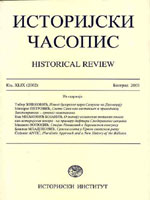Велико краљевство од прва : Крунисање Стефана Немањића и "традиција Дукљанског краљевства"
The Great Kingdom from the Beginning:
Coronation of Stephen Nemanjić
and the “Tradition of the Dioclean Kingdom“
Author(s): Ivana KomatinaSubject(s): History, Middle Ages
Published by: Istorijski institut, Beograd
Keywords: Stephen Nemanjić; Domentijan; Sava Nemanjić; Vukan Nemanjić; Innocent III; Honorius III; Dioclea; Kingdom of Dioclea; Žiča; coronation
Summary/Abstract: Stephen Nemanjić was crowned King of all Serbian and Maritime Lands by the legate sent by Pope Honorius III, in the church of St. Peter and Paul in Ras. We know these details thanks to the sources of Latin provenance: the History of Thomas the Archdeacon and the Chronicle of Andrew Dandolo. Regarding the place of coronation, a later papal act from the 16th century reveals that it was the church of St. Peter and Paul in Novi Pazar. However, in the Serbian hagiographies dedicated to St. Sava, as well as in somewhat later genealogies and annals, a different tradition was recorded. The hagiographers of St. Sava, Domentijan and Teodosije, stated that Sava crowned Stephen king in the Žiča Monastery, and according to them this occurred after the establishment of the Serbian Archbishopric in 1218/1219. Although these statements were rejected by scholars long ago, what awakens the attention of researchers is that Domentijan, unlike Teodosije, did not conceal that the royal crown was brought from Rome and that, according to him, Sava sent an epistle to the then Pope. As Stephen repeatedly sought royal crown from the Pope since 1199 (first of the three missions), the paper raises the question as to what mission and letter of Stephen could be the source for Domentijan when writing about the mentioned epistle in the Life of St. Sava. Presumably, it was the second mission of Stephen and the letter sent on that occasion in 1217 that could serve Domentijan as a source for the story about the epistle, but unfortunately it was not preserved, or the whole paragraph about the epistle in the Life of St. Sava is just Domentijan’s construction. It is interesting that when speaking about the mission to Rome sent to acquire the royal crown, Domentijan denotes bishop Methodius as the bearer of the epistle, the more so because Methodius was mentioned as the bearer in another letter, which Stephen sent to the Pope in 1220 (his third known mission to the Pope). However, the content of the letter from 1220 is completely different from what Domentijan presents as a content of the epistle, and above all in it Stephen titles himself as already a rex coronatus. Domentijan was probably remembering the embassy to Rome in 1220, but as the coronation in his text happened only after the creation of the Serbian Archbishopric, in order to exalt his teacher Sava as the one who awarded the crown to Stephen, he attributed the role of the previous (second) mission of 1217 to the later one (third mission) of 1220. Domentijan among other things notes that Sava wanted to crown his brother king “after the first fatherland of their kingdom…, the place called Dioclea”, which is called “the great kingdom from the beginning”. The statement “the great kingdom from the beginning” is in scholarly works most commonly identified with the „Kingdom of Dioclea“. In this way, the coronation of Stephen would rely upon the tradition of the “Kingdom of Dioclea” of the Serbian rulers Michael and Bodin from the eleventh century. However, following the sources from the eleventh and twelfth centuries, which typically reflect the title of the Serbian rulers of the time, it becomes clear that the “Kingdom of Dioclea“ did not exist, but it was the Serbian kingdom. After all, neither Domentijan determined it in that way, either geographically or ethnically. However, the Kingdom of Dioclea was created in the late twelfth and early thirteenth century, and its creator, as the sources testify, was Vukan Nemanjić, who carried the title of rex Dioclie et Dalmatiae. Nevertheless, this title was restricted to Dioclea and was not related to other Serbian lands. Vukan himself wanted, with the help of King Emeric, to obtain the royal crown from the Pope and become the King of Serbia. When Stephen finally got the royal crown from Rome in 1217, he always emphasized that he was the first, the crowned one, the first-crowned king, and Vukan’s descendants were deprived of any possibility to revive the tradition of his Kingdom of Dioclea. Therefore, there is no doubt that the independent activity of Vukan in Dioclea could have prompted Stephen to present himself before the Pope as the true successor to the old royal tradition. On the other hand, Domentijan himself, who wrote the Life of St. Sava during the reign of King Stephen Uroš Ι, and was instructed by him, could also have intended, or even been obliged, to emphasize the legitimacy of the Rascian rulers (who ruled from Rasa, not from Dioclea) in this part of the Life, and even in the whole work, to mark him as the sole sovereign Serbian king, and to make an ideological link between the Kingdom of Stephen and “the great kingdom from the beginning” of Michael and Bodin.
Journal: Историјски часопис
- Issue Year: 2016
- Issue No: 65
- Page Range: 15-34
- Page Count: 20
- Language: Serbian

